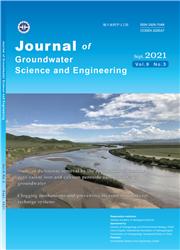基于GIS、遥感和AHP的埃塞俄比亚南部Kulfo-Hare流域地下水潜力分布确定
IF 1.8
4区 地球科学
Q3 WATER RESOURCES
引用次数: 0
摘要
地下水潜力区(GPA)的确定对于面临地表水短缺的地区非常重要,因为它有助于为各种目的有效规划和利用地下水。本研究采用遥感(RS)、地理信息系统(GIS)模型、层次分析法(AHP)、多准则决策分析法(MCDA)等方法对库尔福-黑尔流域地下水远景区进行定位与制图。选取了地质、土地利用/土地覆盖(LULC)、土壤、降雨、坡度、排水密度和地貌密度7个影响地下水潜力的重要因素。采用极低、低、中、高、极高五类分类方案,利用GIS模型确定了地下水潜力区在面积(km2)、百分比和制图方面的分布。结果表明:通过加权叠加评价,研究区地下水潜能值(GWP)分布为:9.7% (6 035.9 ha)为超高潜能值,29.6% (18 606 ha)为高潜能值,24.5% (15 245 ha)为中等潜能值,18.1% (11 431 ha)为低潜能值,18.1% (11 492 ha)为极低潜能值。虽然少数地区被确定为极低的全球升温潜能值,但大多数研究区域的全球升温潜能值都是非常高到中等的。这些发现为政府机构、决策者和私营部门的可持续地下水规划提供了宝贵的见解。本文章由计算机程序翻译,如有差异,请以英文原文为准。
Determination of groundwater potential distribution in Kulfo-Hare watershed through integration of GIS, remote sensing, and AHP in Southern Ethiopia
Identification of groundwater potential areas (GPA) is important in regions facing surface water scarcity, as it assists in effective planning and utilization of groundwater for various purposes. This study employs the methods of remote sensing (RS), geographic information system (GIS) model, and analytical hierarchy process (AHP), multi-criteria decision analysis (MCDA) to locate and map the prospective groundwater areas in the Kulfo-Hare watershed. Seven significant groundwater influencing factors were selected for the determination of groundwater potential in the area: Geology, land use/land cover (LULC), soil, rainfall, slope, drainage density, and lineament density. By applying a five-class classification scheme (very low, low, moderate, high, and very high), the GIS models were used to define the distribution of groundwater potential areas in terms of area coverage (km2), percentage and mapping. The results show that the groundwater potential (GWP) distribution in the research region is as follows: 9.7% (6 035.9 ha) classified as very high GWP, 29.6% (18 606 ha) classified as high, 24.5% (15 245 ha) classified as moderate, 18.1% (11 431 ha) as low and 18.1% (11 492 ha) very low GWP, on the basis of the weighted overlay evaluation. Although a few regions are identifies as extremely low GWP, most of the study area is characterized by very high to moderate GWP. These findings provide valuable insight for sustainable groundwater planning by the government bodies, decision-makers, and private sectors.
求助全文
通过发布文献求助,成功后即可免费获取论文全文。
去求助
来源期刊

Journal of Groundwater Science and Engineering
WATER RESOURCES-
CiteScore
2.80
自引率
9.10%
发文量
308
期刊介绍:
It publishes original, innovative, and integrative research in groundwater science and engineering with a focus on hydrogeology, environmental geology, groundwater resources, agriculture and groundwater, groundwater resources and ecology, groundwater and geologic environment, groundwater circulation, groundwater pollution, groundwater exploitation and utilization, hydrogeological standards and methods, groundwater information science, climate change and groundwater. The Editorial Board is composed of more than sixty world-renowned experts and scholars, 47% of whom are foreign scientists. Up to now, the foreign authors contributed papers are from USA, Japan, Canada, Australia, Russia, Mongolia, Thailand and Vietnam.
 求助内容:
求助内容: 应助结果提醒方式:
应助结果提醒方式:


